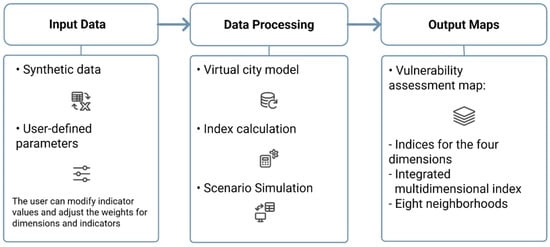- Article
Virtual City Simulator: A Scenario-Based Tool for Multidimensional Urban Flood Long-Term Vulnerability Assessment and Planning in Mediterranean Cities
- Ana Noemí Gomez Vaca,
- Lucía Alexandra Popartan and
- Guillem Armengol Selvas
- + 3 authors
Cities are increasingly vulnerable to flooding due to rapid urbanization and climate change, especially in Mediterranean climates. Although hydroinformatics, numerical modeling, and artificial intelligence can simulate and predict floods with high accuracy, critical gaps persist in assessing flood vulnerability, particularly in data-scarce environments. We present the Virtual City Simulator, a decision-making support platform that evaluates long-term multi-dimension vulnerability to flooding. It combines a synthetic Mediterranean urban model with a composite vulnerability to flooding of index based on four dimensions (social, economic, environmental, physical) and three components (exposure, susceptibility and resilience). We have developed the following: (i) a representative virtual Mediterranean city (500,000 inhabitants, 100 km2; eight neighborhood typologies), (ii) a database with default values of 36 indicators for the eight typical neighborhoods, and (iii) a user-friendly RStudio/Shiny tool that integrates the virtual city and the database, with editable values for indicators and weights, that calculates the multidimensional vulnerability index to floods, and maps the results by dimension and in an integrated way, allowing comparability among scenarios. To illustrate the potential of the tool, the paper includes three case studies: (i) the business-as-usual scenario, using the default values of the indicators and weights of the database, where the most vulnerable neighborhood and dimensions of the virtual city are identified, (ii) the impact of implementing resilience measures in the previously identified vulnerable neighborhood, and (iii) the application of the tool to a neighborhood in a Mediterranean city (Ruzafa-Valencia), combining the available real data with the virtual city database.
13 December 2025







